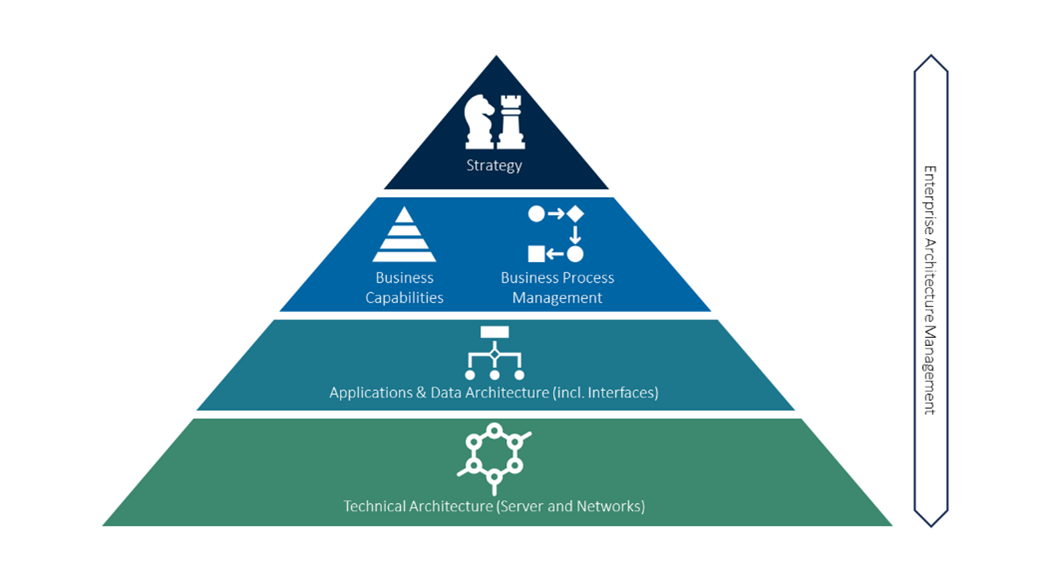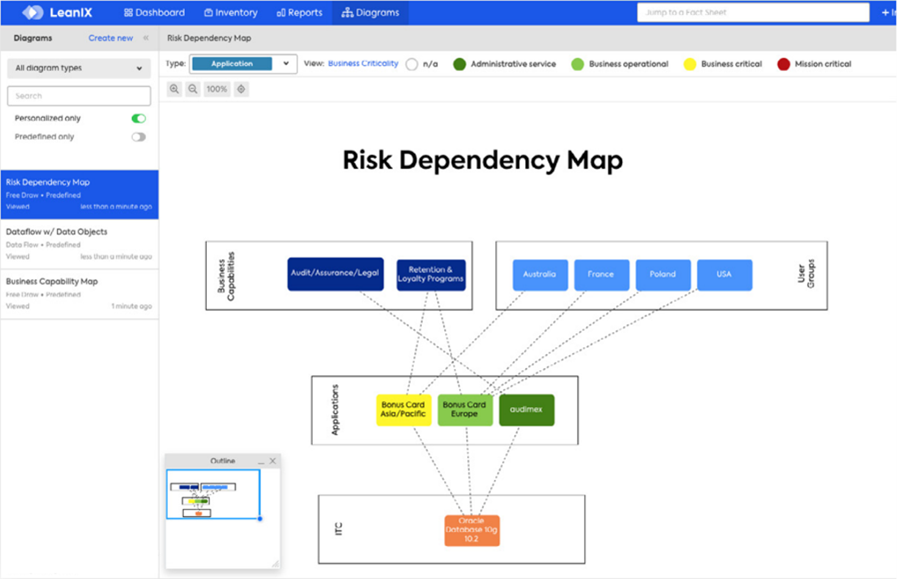
Enterprise Architecture Management
Key competence for a successful and targeted Digital Transformation
Developments in recent years have forced companies to fundamentally rethink their business models, processes and technologies. Enterprise Architecture Management (EAM for short) plays a crucial role in this era of change. EAM enables companies to comprehensively analyze, plan and manage their IT landscapes in order to successfully master the challenges of digital transformation.
Mastering Complexity: Effective Enterprise Architecture Management for a Clear View
In today's business world, many technologies, applications, and systems are in use, leading to considerable complexity. Companies face the challenge of mastering this complexity to successfully implement their Digital Transformation projects. This is where EAM comes into play to provide companies with a clear view of their IT landscapes. EAM makes it possible to translate existing systems, processes, and data flows into clear models and diagrams. This visualization helps to manage resources more efficiently, minimize risks, and make informed decisions. Thanks to the transparency that EAM creates, companies can master the resulting complexity and thus successfully shape their Digital Transformation.
Enterprise Architecture Management (EAM) is a strategic approach to planning, designing, and managing organizational structures, business processes, data objects, applications, and IT infrastructure. EAM helps link IT and business strategies to improve the organization's efficiency and effectiveness. It provides a holistic overview of an organization's current and future direction and enables the identification of potential areas for improvement. In doing so, EAM supports decision-making by providing relevant information, enabling improved strategic planning and implementation.
Aligning Business and IT: A Close Link for Success

The right alignment of business and IT is crucial for a successful digital transformation. EAM helps companies to understand their corporate strategy and goals and translate these into an IT strategy. By closely linking business and IT architecture, companies can ensure that their technological investments meet business requirements and contribute to the achievement of corporate goals. EAM helps to identify dependencies between business processes and IT systems, enabling a holistic view. A coordinated alignment of business and IT through EAM enables companies to make optimum use of their resources, implement projects efficiently and strengthen their competitiveness.
Agility and Innovation: Flexibility as a Competitive Advantage
Digital Transformation requires agility and innovation to meet the challenges of the ever-changing business world. Companies must be able to react quickly to technological developments and market changes and adapt innovative approaches. EAM plays a crucial role in creating an agile and innovative IT landscape. By mapping existing systems and processes, EAM enables companies to integrate new technologies and trends into the IT landscape seamlessly. This allows companies to gain a competitive advantage and bring innovative solutions to market faster. EAM supports companies in flexibly designing their IT landscape, thus enabling a successful Digital Transformation.
Optimizing Costs and Increasing Efficiency: Overcoming the Challenge
Digital Transformation often goes hand in hand with increased complexity and costs. Companies face the challenge of optimizing their IT landscape. The aim is to reduce costs and increase performance. This is where EAM comes into play to help companies successfully overcome this challenge:
Identify redundancies
With the help of EAM, companies can identify redundancies through a comprehensive analysis of the existing IT landscape, companies can identify redundancies with the help of EAM. Companies often have several systems that perform similar functions, which leads to unnecessary costs. By consolidating these systems, companies can reduce IT costs and optimize operations as fewer resources are required for maintenance and administration.
Simplify processes
Another way to optimize costs is to simplify processes. Companies can identify and eliminate superfluous steps by analyzing business processes in detail. EAM makes it possible to map these processes in clear models, thus recognizing the potential for improvement. By optimizing processes, companies can save time and resources and improve the quality of their services.
Strategic planning
In addition, EAM helps companies to plan and manage their IT investments strategically. With a clear view of the IT landscape, companies can set priorities and ensure that their investments meet business requirements. This enables better cost control and prevents unnecessary spending on technologies or applications that do not contribute to the business goal.

Identify weak points
Another aspect of cost optimization is avoiding downtime and disruptions. EAM enables a comprehensive risk analysis by identifying potential weaknesses in the IT landscape. By identifying and eliminating these weaknesses in good time, companies can avoid unforeseen costs caused by downtime and disruptions.
Enterprise Architecture Management thus allows companies to optimize costs, increase efficiency, and strengthen their competitiveness.
Conclusion
In today's world, where Digital Transformation presents companies with significant challenges, Enterprise Architecture Management is indispensable. EAM enables companies to master complexity, ensure business and IT alignment, drive agility and innovation, optimize costs, and increase efficiency. Companies that use EAM as a strategic tool are better equipped to exploit Digital Transformation opportunities and achieve competitive advantages. EAM should, therefore, play a central role in today's corporate strategy. EAM provides companies with the tools and methods to master their IT landscape, achieve their business goals, and strengthen their competitiveness in the digital world. Through a comprehensive analysis, a clear focus, and an efficient IT landscape design, companies can make optimal use of their resources and successfully implement their transformation.
The importance of EAM will continue to grow in the future, as the complexity of Digital Transformation continues to increase. It is time to consider EAM as a strategic tool and integrate it into the corporate and IT strategies to shape Digital Transformation.
Written by






